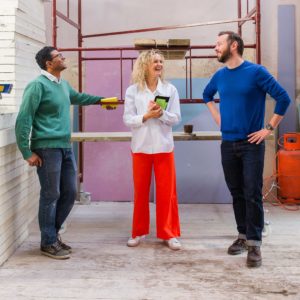Moving towards Regenerative Design
< Back to InsightsBeing a Regenerative Design Practice means going beyond sustainability.
The solutions to the twin climate and biodiversity crisis, and the issues of climate justice that follow closely in their wake, do not lie in sustaining the status quo. Our mission is to make architecture that is beautiful and responsible. This means having a positive, regenerative, impact on our environment and communities.
We are delighted that our approach has been recognised in the first Regenerative Architecture Index. The listing is a partnership between Architects Declare (to whom we are signatories, and Alasdair is on the committee of) and Architecture Today. It’s ambition is to create a ‘Compendium of Best Practice’ for architects to move towards regenerative design.
The aim of the Regenerative Architecture Index is to encourage ways of practicing that are directed towards regenerative goals. It celebrates the companies working in this field and shares best practice to aid a widespread industry shift.
Collective Works were one of the 68 practices who submitted answers to the index that outline how they are embodying regenerative design principles in their work. Three of our answers have been published in the index, showing our approaches to employment, design and community to be of note.
Architecture Today has published the unedited answers from practices that are performing well in each area, runners up and those that gave stand out answers. Together, they are an insight into the challenges and creativity involved in accelerating to a regenerative, more equitable future with the emphasis on sharing knowledge across a range of issues.
To understand the full range of issues that Regenerative Architecture encompasses, questions were divided into three categories:
- Being a good ancestor
- Co-evolving with nature
- Creating a just space for people.
We are pleased to have been credited as a ‘runner up’ and cited as ‘one to watch’ for two more.
Being a good ancestor
One of the key tenets to the thinking behind Regenerative Architecture and Design is to be ‘a good ancestor’.
Architects Declare describe it as “a shift in practice mindsets to consider truly long-term thinking. Our decisions today should consider seven generations ahead, ensuring adaptability and flexibility for the future. This requires innovative thought, as current models are rarely beneficial in the long term.”
Our answer to ‘Does the practice share research and knowledge for the benefit of society and the wider world?’ was listed as a runner up.
We know that our small projects will have limited impact, so beyond the practice we call for collective action.
We share project outcomes through our insights page, in the press and at conferences. Most recently we have published Mid Terrace Dream, a sustainable retrofit in north London and have commissioned a short film to inspire others and attract like-minded clients.
We carry out POE on a selection of projects from each sector and have contributed learnings to the RIBA’s Social Value Toolkit.
Three PHD students are gathering knowledge at our Flourish Wellbeing Hub in Liverpool on how clustering community services improves outcomes locally.
We contribute to a body of knowledge within the profession through RIBA publishing, delivering CPD and teaching. We co-authored RIBA’s Ethical Practice Guide which combines some of our experiences as a practice with a wealth of expert views and frameworks.
Creating a just space for people
The ‘Creating a just space for people’ category looks at how architecture can benefit communities. It also about how architects treat each other in their day to day practice.
In the words of Architecture Declares “This is about providing social connection, economic opportunity and wellbeing for all. Our design processes should foster a shared sense of stewardship where neighbourhoods can self-organise and build their resilience. This requires ethical, inclusive, and participatory approaches.”
Two of our answers were cited as ‘ones to watch’:
Does the practice have a progressive Equalities Diversity and Inclusion policy and can you evidence many forms of diversity which are welcomed and acknowledged within the practice.
We recognise the importance of diversity and are striving to create an inclusive practice. Our practice is both female and global majority led. We also recognise the importance of neurodiversity and believe that taking decisions collectively will lead to better outcomes for all.
We work to ensure representation within our team and seek out consultants from underrepresented groups. The more closely our team reflects the society we wish to serve, the more effectively we’ll be able to work with a broad range of clients and stakeholders.
We are part of the Paradigm network, have spoken up regularly on gender inequity within the profession and have supported Part W Collective, The Just Transition Lobby, and Unheard Voice.

Does the practice operate a no overtime culture, meet the living wage consistently and stipulate a fair salary ration between staff of all levels?
We have championed a zero-overtime culture since our inception. Our team were predominantly contractors when we set up, and this helped us build a culture where each hour is paid, and overtime discouraged.
Our team are also given flexibility as standard, with remote working the norm. This meant one of our team members was able to move back to their home country and has been able to work remotely ever since.
The team enjoy the flexibility this culture enables and regularly adapt work around childcare, parental care, education, and advocacy.
We operate internal transparency on salaries and the largest differential is around 3:1.
Making your project a Regenerative Project
If you want to know more about our approach to Regenerative Design, or want to collaborate on a project that has ambitions towards Regenerative Architecture, please get in touch.
Let’s have a chat about your vision and
how we can help you realise it.
Collective Works are an architecture & design studio. Our network of professionals will create your perfect solution.